Natasha's Dance (37 page)

By midnight denizens and dreamers Moscow most of all is cherished. Here is their home, the fount of all With which this century will flourish.
132
132
4
overleaf:
A typical one-street village in central Russia,
c. 1910
A typical one-street village in central Russia,
c. 1910
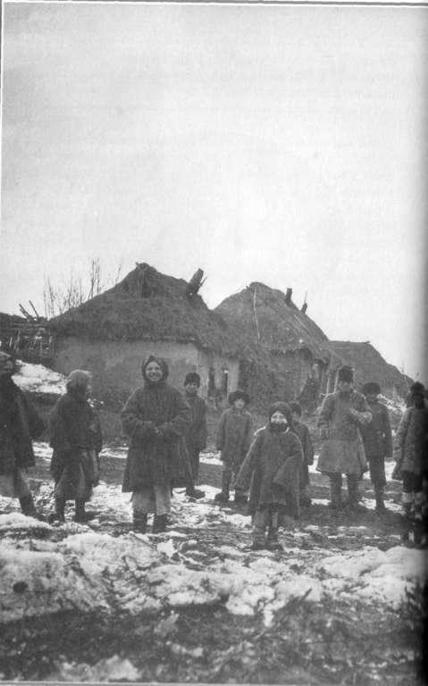
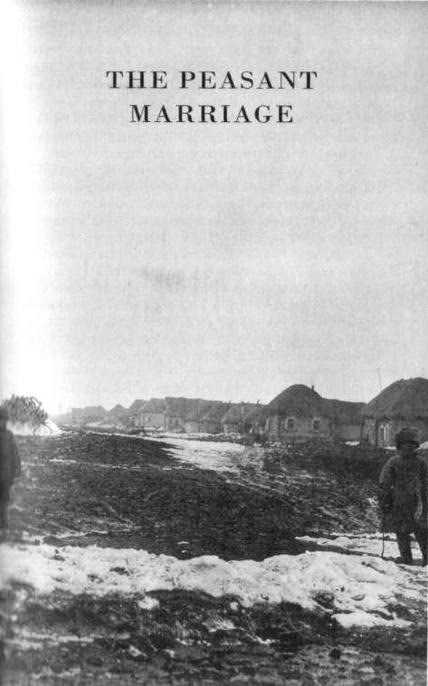
1
In the summer of 1874 thousands of students left their lecture halls in Moscow and St Petersburg and travelled incognito to the countryside to start out on a new life with the Russian peasantry. Renouncing their homes and families, they were ‘going to the people’ in the hopeful expectation of finding a new nation in the brotherhood of man. Few of these young pioneers had ever seen a village, but they all imagined it to be a harmonious community that testified to the natural socialism of the Russian peasantry. They thus convinced themselves that they would find in the peasant a soul mate and an ally of their democratic cause. The students called themselves the Populists
(narodniki),
‘servants of the people’ (the
narod),
and they gave themselves entirely to the ‘people’s cause’. Some of them tried to dress and talk like peasants, so much did they identify themselves with their ‘simple way of life’. One of them, a Jew, even wore a cross in the belief that this might bring him closer to the ‘peasant soul’.
1
They picked up trades and crafts to make themselves more useful to the peasantry, and they brought books and pamphlets to teach the peasants how to read. By merging with the people and sharing in the burdens of their lives, these young revolutionaries hoped to win their trust and make them understand the full horror of their social condition.
(narodniki),
‘servants of the people’ (the
narod),
and they gave themselves entirely to the ‘people’s cause’. Some of them tried to dress and talk like peasants, so much did they identify themselves with their ‘simple way of life’. One of them, a Jew, even wore a cross in the belief that this might bring him closer to the ‘peasant soul’.
1
They picked up trades and crafts to make themselves more useful to the peasantry, and they brought books and pamphlets to teach the peasants how to read. By merging with the people and sharing in the burdens of their lives, these young revolutionaries hoped to win their trust and make them understand the full horror of their social condition.
Yet this was no ordinary political movement. The ‘going to the people’ was a form of pilgrimage, and the type of person who became involved in it was similar to those who went in search of truth to a monastery. These young missionaries were riddled with the guilt of privilege. Many of them felt a personal guilt towards that class of serfs - the nannies and the servants - who had helped to bring them up in their families’ aristocratic mansions. They sought to free themselves from their parents’ sinful world, whose riches had been purchased by the people’s sweat and blood, and set out for the village in a spirit of repentance to establish a ‘New Russia’ in which the noble and the peasant would be reunited in the nation’s spiritual rebirth. By dedicating themselves to the people’s cause - to the liberation of the peasantry from poverty and ignorance and from the oppression of the gentry and the state - the students hoped to redeem their own sin: that of being
born into privilege. ‘We have come to realize’, the prominent Populist theoretician Nikolai Mikhailovsky wrote, ‘that our awareness of the universal truth could only have been reached at the cost of the age-old suffering of the people. We are the people’s debtors and this debt weighs down our conscience.’
2
2
What had given rise to these idealistic hopes was the emancipation of the serfs. Writers such as Dostoevsky compared the Decree of 1861 to the conversion of Russia to Christianity in the tenth century. They spoke about the need for the landlord and the peasant to overcome their old divisions and become reconciled by nationality. For, as Dostoevsky wrote in 1861, ‘every Russian is a Russian first of all, and only after that does he belong to a class’.
3
The educated classes were called upon to recognize their ‘Russianness’ and to turn towards the peasants as a cultural mission - educating them as citizens and reuniting Russia on the basis of a national literature and art.
3
The educated classes were called upon to recognize their ‘Russianness’ and to turn towards the peasants as a cultural mission - educating them as citizens and reuniting Russia on the basis of a national literature and art.
It was such a vision that inspired the students to go to the people. Brought up as they were in the European world of the noble palace and the university, they were on a journey to an unknown land and a new and moral life based on ‘Russian principles’. They saw the emancipation as an exorcism of Russia’s sinful past - and out of that a new nation would be born. The writer Gleb Uspensky, who joined the Populists in their ‘going to the people’, vowed to start a new life in ‘the year of’ 61’. ‘It was utterly impossible to take any of my personal past forward… To live at all I had to forget the past entirely and erase all the traits which it had instilled in my own personality.’
4
4
Some of the Populists who left their parents’ homes to live in labouring communes’ where everything was shared (sometimes including lovers) according to the principles set out by the radical critic Nikolai Chernyshevsky in his seminal novel
What Is to Be Done
(1862). Here was a novel that offered its readers a blueprint of the new society. It became a bible for the revolutionaries, including the young Lenin, who said that his whole life had been transformed by it. Most of these communes soon broke down: the students could not bear the strains of agricultural work, let alone the taste of peasant food, and there were endless squabbles over property and love affairs. But the spirit of the commune, the ascetic lifestyle and material-ist beliefs which the students had imbibed from Chernyshevsky,
What Is to Be Done
(1862). Here was a novel that offered its readers a blueprint of the new society. It became a bible for the revolutionaries, including the young Lenin, who said that his whole life had been transformed by it. Most of these communes soon broke down: the students could not bear the strains of agricultural work, let alone the taste of peasant food, and there were endless squabbles over property and love affairs. But the spirit of the commune, the ascetic lifestyle and material-ist beliefs which the students had imbibed from Chernyshevsky,
continued to inspire their rejection of the old society. This generation gap was the subject of Turgenev’s novel
Fathers and Children
(1862) (often mistranslated as
Fathers and Sons).
It was set in the student protest culture of the early 1860s when the call of youth for direct action in the people’s name opened up a conflict with the ‘men of the forties’, liberal men of letters like Turgenev and Herzen, who were content to criticize the existing state of affairs without addressing the future. Nineteenth-century Russia had its ‘sixties’ movement, too.
Fathers and Children
(1862) (often mistranslated as
Fathers and Sons).
It was set in the student protest culture of the early 1860s when the call of youth for direct action in the people’s name opened up a conflict with the ‘men of the forties’, liberal men of letters like Turgenev and Herzen, who were content to criticize the existing state of affairs without addressing the future. Nineteenth-century Russia had its ‘sixties’ movement, too.
’The peasants have completely overwhelmed us in our literature’, wrote Turgenev to Pavel Annenkov in 1858. ‘Yet I am beginning to suspect that we still don’t really understand them or anything about their lives.’
5
Turgenev’s doubts were at the heart of his critique of the student ‘nihilists’ (as they were called). But they applied equally to the intelligentsia’s obsession with the ‘peasant question’, which dominated Russian culture after 1861. With the emancipation of the serfs, the rest of society was forced to recognize the peasant as a fellow citizen. Suddenly the old accursed questions about Russia’s destiny became bound up with the peasant’s true identity. Was he good or bad? Could he be civilized? What could he do for Russia? And where did he come from? No one knew the answers. For, in the famous lines of the poet Nekrasov:
5
Turgenev’s doubts were at the heart of his critique of the student ‘nihilists’ (as they were called). But they applied equally to the intelligentsia’s obsession with the ‘peasant question’, which dominated Russian culture after 1861. With the emancipation of the serfs, the rest of society was forced to recognize the peasant as a fellow citizen. Suddenly the old accursed questions about Russia’s destiny became bound up with the peasant’s true identity. Was he good or bad? Could he be civilized? What could he do for Russia? And where did he come from? No one knew the answers. For, in the famous lines of the poet Nekrasov:
Russia is contained in the rural depths Where eternal silence reigns.
6
6
Armies of folklorists set out to explore these rural depths. ‘The study of the people is the science of our times’, declared Fedor Buslaev in 1868.
7
Ethnographic museums were set up in Moscow and St Petersburg - their aim being, in the words of one of their founders, Ivan Beliaev, ‘to acquaint the Russians with their own nation’.
8
The public was astounded by the peasant costumes and utensils on display, the photographs and mock-ups of their living quarters in the various regions of the countryside. They seemed to have come from some exotic colony. In almost every field of serious enquiry - geography, philosophy, theology, philology, mythology and archaeology - the question of the peasant was the question of the day.
7
Ethnographic museums were set up in Moscow and St Petersburg - their aim being, in the words of one of their founders, Ivan Beliaev, ‘to acquaint the Russians with their own nation’.
8
The public was astounded by the peasant costumes and utensils on display, the photographs and mock-ups of their living quarters in the various regions of the countryside. They seemed to have come from some exotic colony. In almost every field of serious enquiry - geography, philosophy, theology, philology, mythology and archaeology - the question of the peasant was the question of the day.
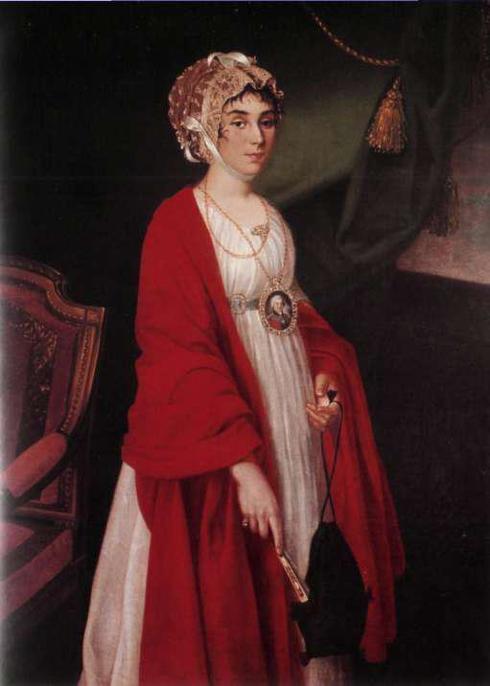
SERF ARTISTS.
Nikolai Argunov:
Portrait of Praskovya Sheremeteva
(1802). At the time of this portrait the serf singer’s marriage to Count Sheremetev (whose image is depicted in the miniature) was concealed from the public and the court. Argunov was the first Russian artist of serf origin to be elected to the Imperial icademy of Arts.
Nikolai Argunov:
Portrait of Praskovya Sheremeteva
(1802). At the time of this portrait the serf singer’s marriage to Count Sheremetev (whose image is depicted in the miniature) was concealed from the public and the court. Argunov was the first Russian artist of serf origin to be elected to the Imperial icademy of Arts.
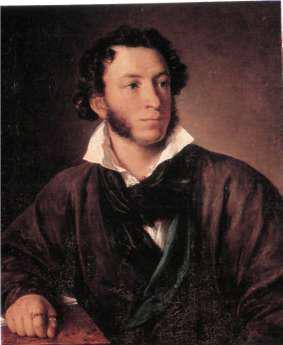
IMAGES OF DOMESTICITY.
Left:
Vasily Tropinin:
Portrait of Pushkin
(1827). Wearing a
khalat,
the writer is portrayed as a European gentleman yet perfectly at ease with the customs of his native land.
Vasily Tropinin:
Portrait of Pushkin
(1827). Wearing a
khalat,
the writer is portrayed as a European gentleman yet perfectly at ease with the customs of his native land.
Below:
Alexei Venetsianov:
Morning of the Lady of the Manor
(1823), a picture of what Herzen called the ‘feudal bond of affection’ between the noble family and its household serfs.
Alexei Venetsianov:
Morning of the Lady of the Manor
(1823), a picture of what Herzen called the ‘feudal bond of affection’ between the noble family and its household serfs.
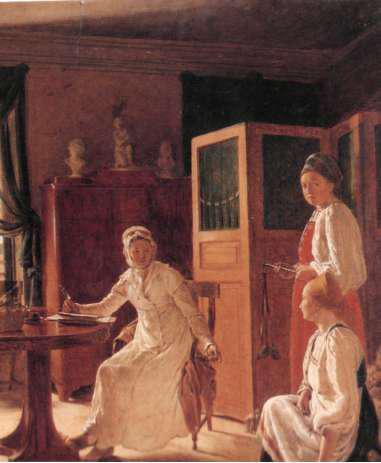
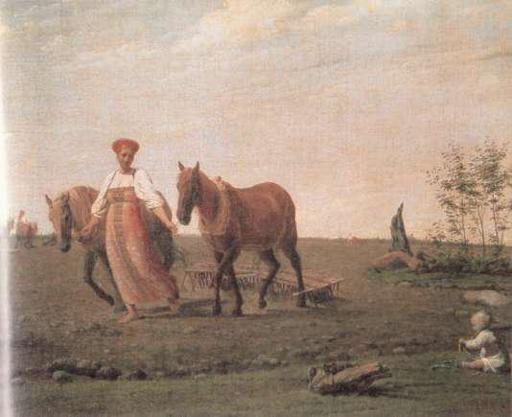
RUSSIAN PASTORAL. Above:
Venetsianov:
In the Ploughed Field: Spring
Venetsianov:
In the Ploughed Field: Spring
Other books
The Quaker and the Rebel by Mary Ellis
Petrodor: A Trial of Blood and Steel, Book 2 by Shepherd, Joel
Spellcasting in Silk: A Witchcraft Mystery by Juliet Blackwell
Kerry Girls by Kay Moloney Caball
Prisoner by Megan Derr
Bill Fitzhugh - Fender Benders by Bill Fitzhugh
Marrying Ember by Andrea Randall
Break Me In by Shari Slade
The Pinnacle Of Empire (Book 6) by C. Craig Coleman
The Private Serials Box Set by Anie Michaels
